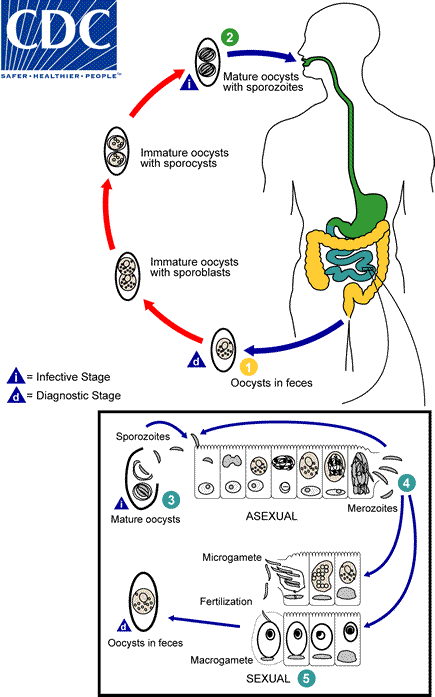Biology
Causal Agent:
The coccidian parasite, Cystoisospora belli, infects the epithelial cells of the small intestine, and is the least common of the three intestinal coccidia that infect humans (the other two are Cyclospora and Cryptosporidium species).
Life Cycle:

At the time of excretion in stool, the oocyst is immature and usually contains just one sporoblast (sometimes, two) ![]() . During further maturation after excretion, the sporoblast divides in two (the oocyst now contains two sporoblasts); the sporoblasts secrete a cyst wall, thus becoming sporocysts; and the sporocysts divide twice, resulting in four sporozoites per each of two sporocysts
. During further maturation after excretion, the sporoblast divides in two (the oocyst now contains two sporoblasts); the sporoblasts secrete a cyst wall, thus becoming sporocysts; and the sporocysts divide twice, resulting in four sporozoites per each of two sporocysts ![]() . Infection occurs by ingestion of mature (fully sporulated) oocysts: the sporocysts excyst in the small intestine and release their sporozoites, which invade the epithelial cells and initiate schizogony
. Infection occurs by ingestion of mature (fully sporulated) oocysts: the sporocysts excyst in the small intestine and release their sporozoites, which invade the epithelial cells and initiate schizogony ![]() . Upon rupture of the schizonts, merozoites are released, which invade epithelial cells and continue the cycle of asexual multiplication
. Upon rupture of the schizonts, merozoites are released, which invade epithelial cells and continue the cycle of asexual multiplication ![]() . Trophozoites develop into schizonts, which contain multiple merozoites. After a minimum of one week, the sexual stage begins, with the development of male and female gametocytes
. Trophozoites develop into schizonts, which contain multiple merozoites. After a minimum of one week, the sexual stage begins, with the development of male and female gametocytes ![]() . Fertilization results in the development of oocysts, which are excreted in the stool
. Fertilization results in the development of oocysts, which are excreted in the stool ![]() .
.
- Page last reviewed: March 17, 2015
- Page last updated: March 17, 2015
- Content source:


 ShareCompartir
ShareCompartir